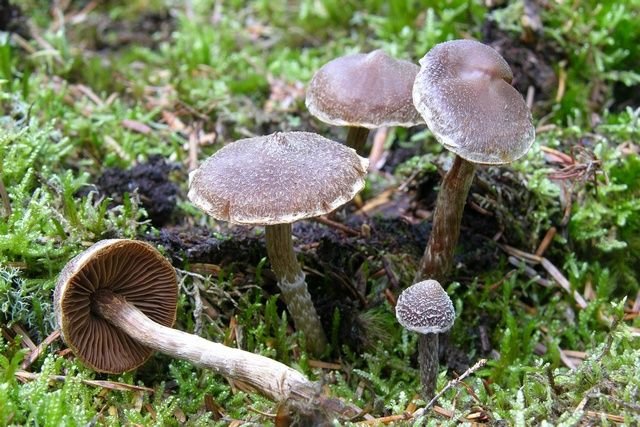Membranous cobweb (Cortinarius paleaceus)
- Pipin: Basidiomycota (Basidiomycetes)
- Ìpín: Agaricomycotina (Agaricomycetes)
- Kilasi: Agaricomycetes (Agaricomycetes)
- Ipin-ipin: Agaricomycetidae (Agaricomycetes)
- Bere fun: Agaricales (Agaric tabi Lamellar)
- Idile: Cortinariaceae (Spiderwebs)
- Ipilẹṣẹ: Cortinarius (Spiderweb)
- iru: Cortinarius paleaceus (Membranous cobweb)

Apejuwe:
Cap 2-3 (3,5) cm in diameter, bell-shaped, convex with a sharp mastoid tubercle, dark brown, brown-brown, sometimes with radial light brown stripes, ocher-brownish in dry weather, with whitish-felt scales, especially noticeable closer to the edge and the remains of a light veil on the edge.
The plates are sparse, wide, adnate with a tooth or free, brown, then rusty-brown.
The leg is long, 8-10 (15) cm and 0,3-0,5 cm in diameter, thin, curved at the base, hard, fibrous-grooved, hollow inside, brown-brown, covered with whitish silky-felt belts, with large gray scales at the base.
The flesh is thin, brittle, firm in the stem, brownish, odorless, according to the literature with the smell of geranium.
Tànkálẹ:
The cobweb grows from late July to mid-September in a mixed forest (with birch), around swamps, in mosses, not often, sometimes abundantly.
Ijọra naa:
The cobweb membranous has a very close appearance, the cobweb membranous-wild, which is distinguished by a purple tint of the plates and the upper part of the stem, is sometimes considered a synonym. Great resemblance to Gossamer cobweb, from which it differs in smaller size, distinct scales, growing in moss in a swamp.









